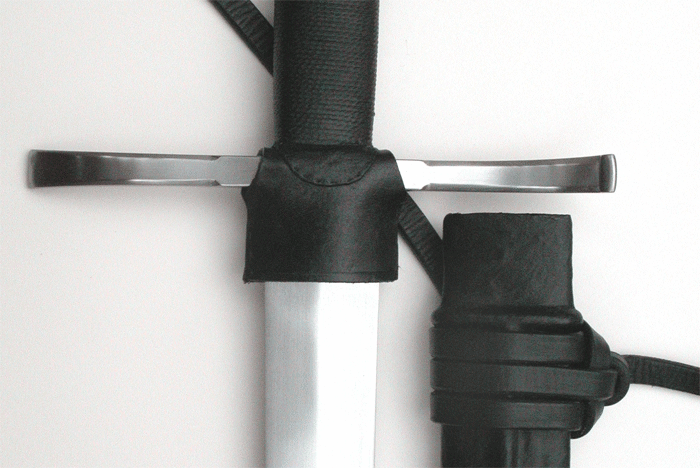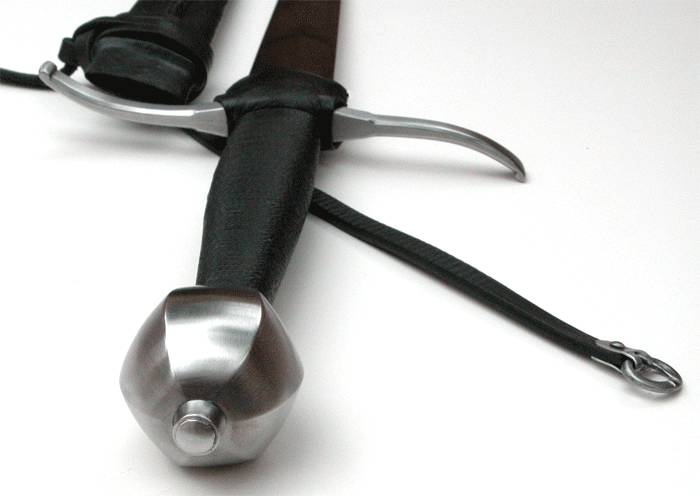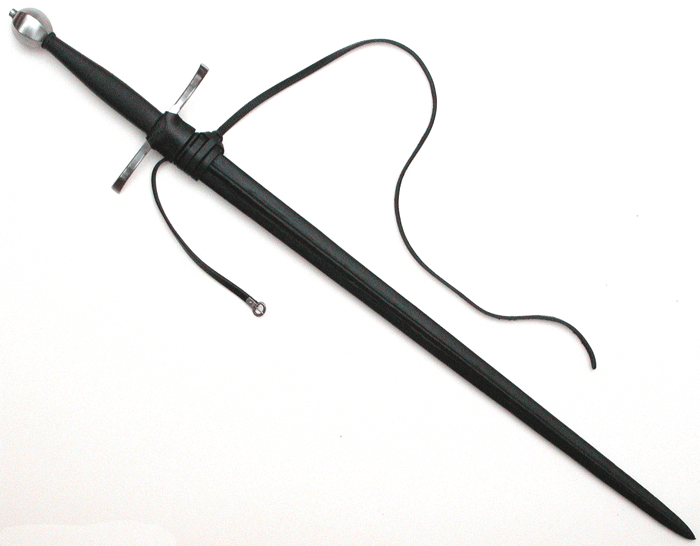Hi,
thanks for your thoughts.
I will address some of them, though you might forgive if I repeat myself. I am having this discussion on four forums and two mailing lists at the moment!
First, these guard attachments are present in European art from around 1300 onwards, regardless of place. I don't think their appearance was limited to any region. Please correct me if I am mistaken.
Rain guard:
Honestly, if you just picture the amount of water it would take to enter a scabbard, you will realize that the very idea is shere nonsense. In rain, the complete sword (including the hilt!) would be better protected under a cloak! A soldier on campaign will have to clean his sword from mud and gore, grind out nicks and re-sharpen it, oil it and put it back into the scabbard. And - do you notice: There is no flap to cover the scabbard mouth while the sword is drawn! Why? Because the opening is so tiny that you would have a hard time getting a lot of water in even if you tried it on purpose. Leave alone when the sword is inside!
Any moisture remaining in the leather will stain the cross guard and eventually the base of the blade much more significantly, even after the biblical floods of rain have stopped. It would be easier to discard the leather, clean your sword and keep it nicely oiled.
So please, please, don't call it a rain guard. That is utter nonsense.
Now, a more interesting objection against the protection thesis: Why not make them of metal? Well there are a couple of surviving pieces that do sport a tubular metal piece which covers the base of the blade just below the cross. They can also be seen with some later and much more elaborate swords. It has been pointed out that these later swords' complex hilts offer sophisticated hand protection. So it seems that here the tube can only be intended to seal the scabbard mouth.
While I appreciate the nice fit on the scabbard that my cross guard leather provides and while I am convinced that this was an appreciated side benefit back then, too, there is suppossedly more to it.
Brian Mcilmoyle kindly shared his experience in private correspondence (I take the liberty here to quote him):
Their existance on complex hilts adds rather than detracts to this as even complex hilts provide little protection from a point in line with the blade. ( my current study of the rapier providing lots of experiencial evidence of this ) The fact that many rapiers are furnished with this protection in steel ( cup hilts come to mind) add to the evidence.
Have a look at the famous
Vasa sword, keeping Brian's words in mind!
I can understand that if you do not have according experience it is hard to imagine that such a little tube can put a point offline in a significant manner. Well, it surely does not make up for bad fencing but it keeps your hand safe when it counts.
More Examples with
metal tubular guards from Vienna,
Munich and the
arms collection in
Dresden.
None of these examples is 14th or early 15th century. So what made them stick with the leather attachments for so long and why was leather never given up completely?
Before I address this question I would first like to explain why the tubular type might have evolved from the flap type:
The early flap type (the one that is not fixed to the blade) does its job nicely: The blade sliding down from the bind folds back the flap and is deviated. Finger remains unscathed. However, it showed that the flap may deviate the opponent's blade too much and eventually results in losing the bind.
This means losing control of the opponent's weapon.
Fixing the flap to the blade base was an obvious solution. It still offered enough point deviation but reduced the loss of the bind because the flap couldn't fold back any more. Consequently the flap was reduced in size and lost its original purpose. The protection was now merely offered by the tube around the blade.
We might also want to consider that the more your fencing is focused on thrusting from the bind, the better a tubular type serves your purpose. If your fencing sees a lot of cutting and blows you may be better off with the flap type.
This would explain why both types remained in use.
But why leather?
I think that is pretty obvious with the flaps: Leather folds back, metal doesn't. Metal rather has another disadvantage: It tends to make a blade bumb off. Leather absorbs energy and traps the blade. Which is exactly what showed in recent tests with sharps: The incoming blade's remaining energy (remember it is sliding in from the bind) is virtually choked, control is perfect. (I have seen the according videos taken by friends of mine who decided to not publish them on the net for liability issues).
Of course, everything comes at a price. Leather will be cut and wear out and needs to be replaced at one point, whereas metal won't.
The fact that these cross guard attachments were very ornate and were used to express a sense of fashion is really no reason to doubt that they had a protective value. Plate armour, for example, didn't evolve much after 1500, it just became more and more ornate. Still it remained armour.
And finally:
The idea that these leathers may have been intended to prevent the blade from being stained when using thumb grips as often done in German swordsmanship has been raised a couple of times.
Well, from experience I can only say that cross guard leathers make it hard to polish the guard and the base of the blade. And these parts will stain never-the-less if not oiled and sustained appropriately.
The leather itself neither obstructs nor helps with thumb grips.
Let me conclude with another quote from Mr Mcilmoyle:
I require no evidence or proof to benefit my assessment other than a single injury foiled.
All the best,
Roland


